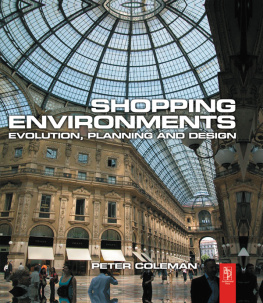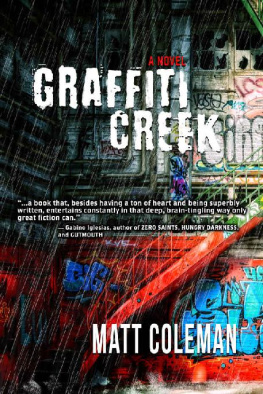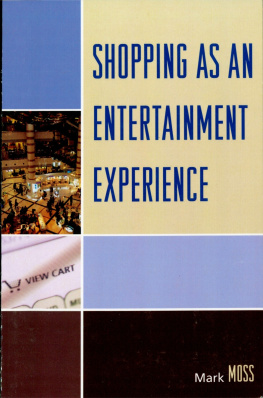Shopping Environments
Evolution, Planning
and Design
Shopping Environments
Evolution, Planning
and Design
Peter Coleman

Architectural Press is an imprint of Elsevier Ltd
Linacre House, Jordan Hill, Oxford OX2 8DP, UK
30 Corporate Drive, Suite 400, Burlington MA 01803, USA
First edition 2006
Copyright 2006, Peter Coleman. All rights reserved
The right of Peter Coleman to be identified as the author of this work has been asserted in accordance with the Copyright, Designs and Patents Act 1988
No part of this publication may be reproduced, stored in a retrieval system or transmitted in any form or by any means electronic, mechanical, photocopying, recording or otherwise without the prior written permission of the publisher
Permission may be sought directly from Elseviers Science & Technology Rights Department in Oxford, UK: phone (+44) (0) 1865 843830; fax (+44) (0) 1865 853333; email: , and selecting Obtaining permission to use Elsevier material
Notice
No responsibility is assumed by the publisher for any injury and/or damage to persons or property as a matter of products liability, negligence or otherwise, or from any use or operation of any methods, products, instructions or ideas contained in the material herein. Because of rapid advances in the medical sciences, in particular, independent verification of diagnoses and drug dosages should be made
British Library Cataloging in Publication Data
A catalogue record for this book is available from the British Library
Library of Congress Cataloging in Publication Data
A catalog record for this book is available from the Library of Congress
ISBN 13-978 0 7506 6001 3
ISBN 10-0 7506 6001 5
For information on all Architectural Press publications visit our website at www.books.elsevier.com

Contents
Foreword
I t is likely to be provocative and self-defeating to suggest that no one individual person actually fully understands all the issues and considerations in the formulation and design, from start to finish, of a typical shopping centre. Having undertaken the research and completed the writing, I feel well positioned to make this observation. Shopping centres are big, complex developments involving the skills of a large team of designers and specialist consultants who contribute at particular stages throughout the project. Typically, the process of forming a shopping centre can last, from inception to completion, for a period of 10 years or more, involving the contribution of many specialist consultants. Invariably, those best placed to understand all the issues in the process of making a shopping centre are likely to be a combined team consisting of the client, architect and retail team. The process can be compared to a cross between a marathon and a relay race where the project is the baton and a gradually changing team of runners carries it through the race. Although the architect will be involved in most stages of the race, it is likely that supporting runners will come alongside at different stages and may even carry the baton at some points. While a stakeholder or consultant is carrying the baton, the architect may be required to run alongside as part of the team for this stage. The challenge to the architect will be twofold: first, to understand at which stages to run with the baton or to run alongside; and second, to maintain sufficient tenacity to be the custodian of the vision through the different stages until completion.
This book will hopefully help all those involved in the design of shopping centres to recognise the format of the event, when to run or just to jog, and with whom they should be running.
Preface
T his book was instigated from a need to update the original book Shopping Centres: Retail Development, Design and Management written by Nadine Beddington in 1981 (with a second and revised edition published in 1991, published by Architectural Press). However, much has happened in the development of shopping centres since the update of the original book, responding to social, planning, economic and technological changes. Key influences upon the development of the building type have been, for example:
 working patterns requiring more convenience and customer specific shops
working patterns requiring more convenience and customer specific shops
 more discerning customers expecting greater value and more memorable experiences
more discerning customers expecting greater value and more memorable experiences
 government policies restricting out-of-town development and requiring more sustainable and inclusive town centre shopping development
government policies restricting out-of-town development and requiring more sustainable and inclusive town centre shopping development
 technological advancement:
technological advancement:
 aiding retailers with bar code sales and corresponding automated just in time deliveries
aiding retailers with bar code sales and corresponding automated just in time deliveries
 increasing the availability of information, facilitating the monitoring of turnover rents
increasing the availability of information, facilitating the monitoring of turnover rents
 generating greater competition from alternative modes of shopping (Internet shopping).
generating greater competition from alternative modes of shopping (Internet shopping).
General progress, since the original book, has seen a new type of shopping centre emerge and the opening of many exciting new centres. Such is the rate of progress and change in the retail industry that it has been necessary for the book to be totally re-researched and rewritten.
The overall aim and objective of this book is to identify the principal issues and considerations an architect is likely to encounter in the design of a shopping centre. With the average shopping centre taking some 10 years to complete from inception, a key characteristic of this building type will be found in understanding the influence of the lengthy process upon its design and planning. Shopping centres are complex public buildings, meeting the needs of several different stakeholders and users, and involving clients, retailers, customers and the general public.
The book aims to build up an understanding of the building type through the examination of the following:
 an outline of the background and development of facilities for shopping
an outline of the background and development of facilities for shopping
 an identification of the different types of shopping centre and the ongoing evolution of new formats
an identification of the different types of shopping centre and the ongoing evolution of new formats
 an outline of different client requirements and the influence of various stakeholders
an outline of different client requirements and the influence of various stakeholders
 the influence of the process and how the brief will evolve over the length of the project
the influence of the process and how the brief will evolve over the length of the project
 the (key) issues to consider in initiating the project and preparing the brief
the (key) issues to consider in initiating the project and preparing the brief
 the types of accommodation to be included in the building
the types of accommodation to be included in the building

Next page














 working patterns requiring more convenience and customer specific shops
working patterns requiring more convenience and customer specific shops aiding retailers with bar code sales and corresponding automated just in time deliveries
aiding retailers with bar code sales and corresponding automated just in time deliveries